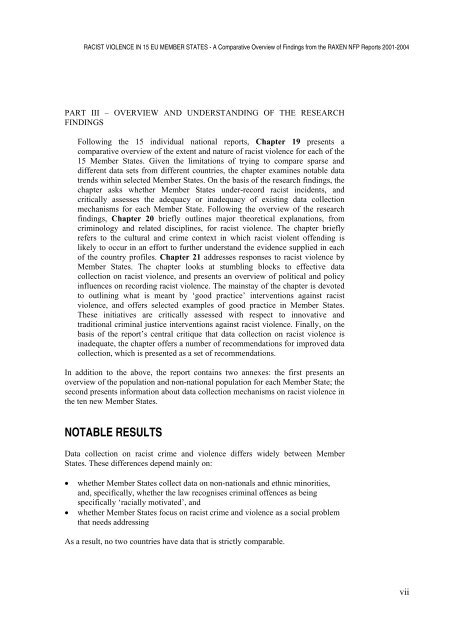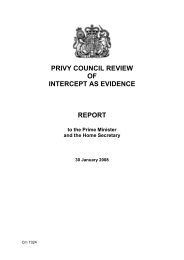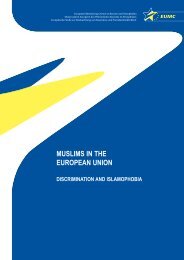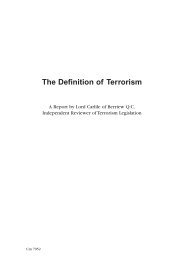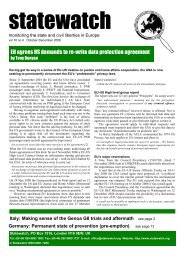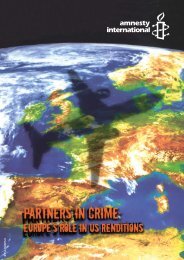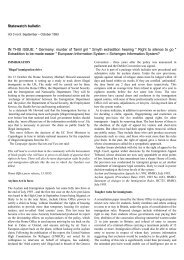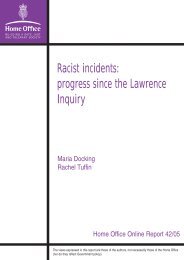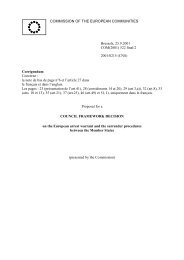RACIST VIOLENCE IN 15 EU MEMBER STATES - Cospe
RACIST VIOLENCE IN 15 EU MEMBER STATES - Cospe
RACIST VIOLENCE IN 15 EU MEMBER STATES - Cospe
You also want an ePaper? Increase the reach of your titles
YUMPU automatically turns print PDFs into web optimized ePapers that Google loves.
<strong>RACIST</strong> <strong>VIOLENCE</strong> <strong>IN</strong> <strong>15</strong> <strong>EU</strong> <strong>MEMBER</strong> <strong>STATES</strong> - A Comparative Overview of Findings from the RAXEN NFP Reports 2001-2004<br />
PART III – OVERVIEW AND UNDERSTAND<strong>IN</strong>G OF THE RESEARCH<br />
F<strong>IN</strong>D<strong>IN</strong>GS<br />
Following the <strong>15</strong> individual national reports, Chapter 19 presents a<br />
comparative overview of the extent and nature of racist violence for each of the<br />
<strong>15</strong> Member States. Given the limitations of trying to compare sparse and<br />
different data sets from different countries, the chapter examines notable data<br />
trends within selected Member States. On the basis of the research findings, the<br />
chapter asks whether Member States under-record racist incidents, and<br />
critically assesses the adequacy or inadequacy of existing data collection<br />
mechanisms for each Member State. Following the overview of the research<br />
findings, Chapter 20 briefly outlines major theoretical explanations, from<br />
criminology and related disciplines, for racist violence. The chapter briefly<br />
refers to the cultural and crime context in which racist violent offending is<br />
likely to occur in an effort to further understand the evidence supplied in each<br />
of the country profiles. Chapter 21 addresses responses to racist violence by<br />
Member States. The chapter looks at stumbling blocks to effective data<br />
collection on racist violence, and presents an overview of political and policy<br />
influences on recording racist violence. The mainstay of the chapter is devoted<br />
to outlining what is meant by ‘good practice’ interventions against racist<br />
violence, and offers selected examples of good practice in Member States.<br />
These initiatives are critically assessed with respect to innovative and<br />
traditional criminal justice interventions against racist violence. Finally, on the<br />
basis of the report’s central critique that data collection on racist violence is<br />
inadequate, the chapter offers a number of recommendations for improved data<br />
collection, which is presented as a set of recommendations.<br />
In addition to the above, the report contains two annexes: the first presents an<br />
overview of the population and non-national population for each Member State; the<br />
second presents information about data collection mechanisms on racist violence in<br />
the ten new Member States.<br />
NOTABLE RESULTS<br />
Data collection on racist crime and violence differs widely between Member<br />
States. These differences depend mainly on:<br />
• whether Member States collect data on non-nationals and ethnic minorities,<br />
and, specifically, whether the law recognises criminal offences as being<br />
specifically ‘racially motivated’, and<br />
• whether Member States focus on racist crime and violence as a social problem<br />
that needs addressing<br />
As a result, no two countries have data that is strictly comparable.<br />
vii


